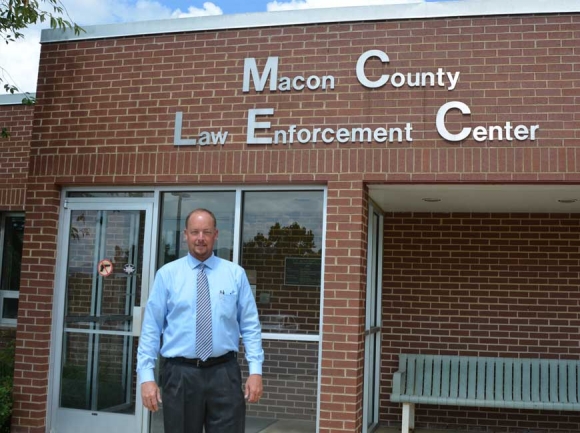New jail, justice center top needs in Macon
 Macon County Sheriff Robbie Holland is exploring the option of transporting inmates as far as Mecklenburg County to combat the overcrowded detention center on Lakeside Drive. File photo
Macon County Sheriff Robbie Holland is exploring the option of transporting inmates as far as Mecklenburg County to combat the overcrowded detention center on Lakeside Drive. File photo
In an effort to prioritize its long list of infrastructure needs, Macon County Board of Commissioners approved spending up to $300,000 last November to hire Moseley Architects to conduct a space needs analysis of county buildings.
This November, the consultants came back to the board presenting a list of top priorities totaling more than $125 million in needed infrastructure projects. A massive project to consolidate the courthouse, sheriff’s department and the detention center operations into a new justice center complex would cost the county an estimated $77.3 million with construction costs expected to rise in the coming years.
Right now the detention center and sheriff’s office are located in the Law Enforcement Center off Lakeside Drive while the courthouse is located in downtown Franklin, which creates an increased cost to personnel needed to transport inmates for court appearances. The current 75-bed jail also is not big enough to meet the demand in Macon County. The detention center is regularly at capacity, and the county is shelling out more than $500,000 a year to house its inmates in other county jails.
With most of the jails in Western North Carolina facing the same overflow problems, Sheriff Robbie Holland said he was having to explore the idea of housing Macon inmates as far as Mecklenburg County as well.
Dan Mace with Moseley Architects emphasized the importance of getting a handle on the overcrowded jail situation.
“There’s no other county building that takes the kind of abuse as a detention center does,” he said. “It’s never closed and its occupants are trying to tear it up.”
Related Items
While capacity is 75 inmates, the 20-year-old jail had an average daily population of 105 in 2018. The jail also only has 12 beds available for female inmates. Mace pointed out that jails have a rated capacity and then there’s what’s considered a safe operational capacity, which Macon’s facility is way over. According to the National Institute of Corrections, jails should operate at 80 percent of its rated capacity.
“That’s where you can typically safely operate a detention facility because you can’t put a male in a female unit or vice versa, so this will continue to get worse if not addressed,” he said. “It’s a critical issue and the reason we prioritized the justice center because if you don’t have the space to adjudicate those people in a timely manner, the number of people in jail will continue to rise.”
The proposed 240-bed detention center piece of the project is estimated to cost $37.5 million. The county does not currently need 240 beds, but Mace said it would accommodate the county’s needs looking 20 years ahead. In the meantime, he suggested extra beds could be used to help other counties house their overflow and help Macon bring in additional revenue. Moseley estimated the new sheriff’s office would cost about $9 million and the courthouse component would cost another $31 million. Macon County would see a savings in transportation, utilities and personnel costs by combining all these services into one complex, similar to what Jackson County did years ago.
Bryan Payne, project manager with Moseley Architects, said the project could be broken up into separate phases as funds become available.
Commissioner Ronnie Beale asked if the current jail could be renovated or would need to be completely rebuilt.
Mace said the current facility couldn’t be renovated to meet the future needs because the detention center doesn’t have a commercial kitchen or enough room to accommodate a 240-bed plan. However, he said Moseley’s complete analysis would have recommendations for using the current law enforcement center instead of bulldozing it.
“Remember the uproar when we built the jail? They said we’d never need that much space and here we are,” Beale said.
Once a new justice center complex is completed, the county could move to the second priority project, which would be repurposing the current courthouse building and renovating the annex facilities in downtown. Renovating the courthouse would cost an estimated $17.3 million, the county courthouse annex would cost about $2.3 million and renovating the current Southwestern Community College annex would cost another $2 million.
With all the court functions moved to the new justice center, Moseley recommends using the courthouse building to consolidate the other county services — IT and future expansion space on the basement floor and register of deeds, board of election and others on the first floor.
The next priority would be to renovate the current National Guard Armory building and relocate the county’s housing department from its Old Murphy Road location. The county could then sell that property. Moseley also recommended moving the SCC classrooms to the armory building, which would also have future room for SCC’s new public safety training center that’s in the works.
Future projects that are included but are not as pressing include renovating the Department of Health and Human Services building to address the projected growth needs and to accommodate the dental clinic, which is currently located at a separate facility the county is leasing. The project would cost $7.6 million.
Moseley recommended a new emergency management headquarters as well — an $11.3 million project.
“Those folks are very cramped right now,” Payne said. “And we could create a new 911 facility that meets modern day codes.”
Two other projects that have been discussed at length by the county commissioners and residents did not make the top of the priority list — the senior center and the Nantahala Community Center, which also houses the community library resources.
Payne said most of the issues at the senior center — issues with a lack of parking and ADA accessibility — could be handled with a minor renovation project at this point. Such a project would cost about $4.1 million.
The Nantahala community has been pushing for a replacement building for its small and antiquated community center and library, which is housed in a deteriorating modular unit, but the county lacks the property needed to build a new facility. Moseley estimates replacing the building would cost about $4 million.
Mace said commissioners would be given a complete space needs analysis document in the coming months with full details about each building that was examined and the recommendations made for each one’s future use. Mace said they assessed every building’s electrical and plumbing, each department’s operations and machinery, and assessed its current condition and usability for the next 20 years.
“We also met with representatives from each department to identify their priorities and needs in the future,” he said.
Commissioner Gary Shields asked why the report didn’t include anything about a future replacement of Franklin High School.
Mace said K-12 education facilities were not included in the study.
County Manager Derek Roland said the complete analysis would help the county moving into the next budget year as well as into the future as the commissioners plan on infrastructure needs. While the cost is high looking at the big picture, Roland said the replacement and renovation projects would also help the county save money in the future by alleviating some of the growth concerns within the departments and consolidating services and staff.
Now the board will use the analysis report from Moseley to further develop the county’s Capital Improvement Plan before next year’s budget process.









